By William P. Marchione

The Noah Worcester House, built in the 1680s, one of the oldest houses in Brighton Center, the residence in the 1810 to 1837 period of Dr. Noah Worcester, the founder of the American Peace Movement who also served as Brighton’s first postmaster. The year the house was decorated with these flags is uncertain; possibly the 1876 U.S. Centennial Celebration. Today a row of three deckers occupy the lot on which this house once sat, at the northwest corner of Washington and Foster Streets.
A visit to the Brighton-Allston Heritage Museum, located at the bottom level of the Veronica Smith Senior Center on Chestnut Hill Avenue, is recommended in advance of taking this walking tour. The museum, which is just a few steps from stop #1 of the tour, is organized around six themes in the history of the Allston-Brighton, all of which are represented to some degree in the Brighton Center walk.
The Brighton-Allston Heritage Museum was established in February 2007 as initial event in a Bicentennial celebration marking the 200th birthday of the foundation of the Town of Brighton in 1807.
 The Kickoff reception of the Allston-Brighton Bicentennial Celebration in the auditorium of the Smith Senior Center. This also marked the inauguration of the Brighton-Allston Heritage Museum.
The Kickoff reception of the Allston-Brighton Bicentennial Celebration in the auditorium of the Smith Senior Center. This also marked the inauguration of the Brighton-Allston Heritage Museum.
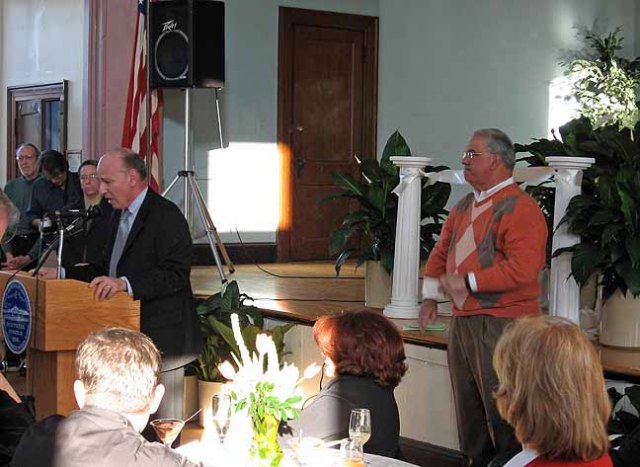 Brighton-Allston Historical Society President Bill Marchione welcomes the attendees, with Boston Mayor Tom Menino looking on at the far right.
Brighton-Allston Historical Society President Bill Marchione welcomes the attendees, with Boston Mayor Tom Menino looking on at the far right.
 Boston Mayor Tom Menino touring the Brighton-Allston Heritage Museum
Boston Mayor Tom Menino touring the Brighton-Allston Heritage Museum
Stop #1 – Vantage Point: The Northeast corner Washington & Market Streets in front of the Washington Building.
 A postcard view of the Washington Building, Brighton Center’s most prominent commercial landmark, a structure built in the late 1890s, situated at the northeast corner of Market and Washington Streets.
A postcard view of the Washington Building, Brighton Center’s most prominent commercial landmark, a structure built in the late 1890s, situated at the northeast corner of Market and Washington Streets.
Early Roadways emanating from Brighton Center: Here we stand at the point of convergence of the three main historic roadways running in and out of Brighton Center: (1) Washington Street (formerly known as the Road to the Watertown Mill), running west led to the only gristmill in the general area, situated in Watertown Square). Traveling in the opposite direction, to the east, Washington Street gave access first to Brookline Village, and then to Roxbury and the Roxbury Neck, leading into Boston. Prior to 1821 and the building of the Mill Dam Road across the as yet unfilled Back Bay, this was the main road from Brighton into the great port city of Boston; (2) Market Street (originally known as Meeting House Lane), running north from this point to the edge of the Charles River, then to bridges that connected to Brighton’s northern neighbors, Cambridge and Watertown; and (3) Chestnut Hill Avenue (originally known as Rockland Street), which gave access to the communities lying to the south (the central portion of Brookline and Dedham beyond).
 The Little Cambridge Meetinghouse, 1744
The Little Cambridge Meetinghouse, 1744
Little Cambridge: Brighton was part of the Town of Cambridge before 1807, the only section of Cambridge located south of the Charles River, an area known as “Little Cambridge.” Prior to 1744 the residents of Little Cambridge, who were members of the First Church of Cambridge, were obliged to travel to distant Harvard Square on the opposite of the Charles River for religious services. Their burial ground was the historic graveyard adjacent to the Cambridge Church. A local meetinghouse (seen above) was built in 1744, but for many years it was used only during the winter months when travel to the Cambridge church was difficult.
A local schoolhouse was built just east of the meetinghouse and a local burying ground laid out at the north side of the meetinghouse (the present Market Street Burial Ground). Not until the time of the American Revolution, however, was ecclesiastical independence granted to the Little Cambridge congregants, their meetinghouse then becoming the Third Parish Church of Cambridge. In 1787 the Reverend John Foster was named the first permanent minister. Reverend Foster’s wife, Hannah Webster Foster, was, in fact, more notable a figure than her husband. In addition to organizing the first women’s club in Massachusetts in her husband’s parish, in 1797 Mrs. Foster became the first native born American woman to write a novel. We’ll have more to say about Hannah Foster when we reach the First Church Parsonage, toward the end of this walk.
 The First Church of Brighton, second building, constructed in 1808
The First Church of Brighton, second building, constructed in 1808
First Church of Brighton, 1808 (Unitarian): In 1807 when Little Cambridge separated from the parent town, the 1744 meetinghouse was moved across Washington Street (to the site where the Brighton Elks Hall now stands) where for the next 34 years it served as Brighton’s town hall. A new church edifice constructed in 1808 at public expense on the old lot, Congregationalism then being an established religion in Massachusetts. Many of the state’s Congregational denominations experience schisms in these years, with some adhering to traditional Congregational practices, while others embraced the newer and more liberal Unitarian creed. The majority of the First Parish Church members and their Minister, John Foster, opted for Unitarianism.
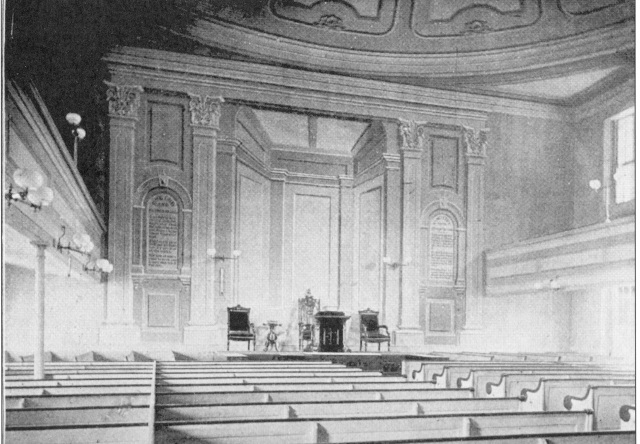 First Church of Brighton (1808), interior view. The elegant proportions of this church, which was built at public expense, reflects the great prosperity Brighton was experiencing in these years, owing to its position as the headquarters of the New England cattle and slaughtering trades.
First Church of Brighton (1808), interior view. The elegant proportions of this church, which was built at public expense, reflects the great prosperity Brighton was experiencing in these years, owing to its position as the headquarters of the New England cattle and slaughtering trades.
Stop #2 – The northwest corner of Washington and Market Streets facing west
 An engraving of Brighton Center as it looked in the 1830s. The cattle pictured here were being herded to the Brighton Stockyards, which stood behind this hotel.
An engraving of Brighton Center as it looked in the 1830s. The cattle pictured here were being herded to the Brighton Stockyards, which stood behind this hotel.
On the left hand side of this illustration stands the original Cattle Fair Hotel, dating from 1830. The 1808 First Parish Church stands at the center. Brighton’s first school house is visible in the distance behind the signpost. The Greek Revival style building on the extreme right was the first headquarters of the Bank of Brighton, an institution founded in the early 1830s when few Massachusetts towns had banks of their own. As a commercial center Brighton had need of the services of a bank.
The American Revolution marked a major turning point in the history of Little Cambridge. Prior to that conflict the part of Cambridge lying south of the river had been a prosperous farming community, containing many as well as prosperous smaller farms. In 1776, responding to the need of General Washington’s Continental Army, then headquartered across the Charles River in Cambridge proper, Jonathan Winship I and II of Brighton, sent out word to the farmers of Middlesex County and other outlying areas to send their livestock to Little Cambridge, where it would be processed to meet the needs of the army. The original Cattle Market was located on the grounds of the Bull’s Head Tavern about a quarter of a mile east of the village on the site of present-day 201 Washington Street.
 The original site of the Brighton Cattle Yards was in and around the Bull’s Head Tavern, probably on the flat piece of land opposite that hostelry through which a stream then ran, the area between present day Shepard, Shannon and Snow Streets.
The original site of the Brighton Cattle Yards was in and around the Bull’s Head Tavern, probably on the flat piece of land opposite that hostelry through which a stream then ran, the area between present day Shepard, Shannon and Snow Streets.

The Cattle Fair Hotel & the Brighton Center Stockyards, 1830-1884: Then about 1830 the Cattle Market moved to Brighton Center to an eleven acre parcel behind the newly constructed Cattle Fair Hotel. The first manager of the Cattle Fair Hotel was the famed Zachariah Porter who afterwards ran the Porter House Hotel in present-day Porter Square, Cambridge, the namesake of the Porter House steak. The Cattle Fair Hotel had been incorporated by the Commonwealth of Massachusetts to accommodate the many drovers, cattle dealers, and farmers who converged on Brighton on a weekly basis to trade at the Brighton Stockyards, and also to operate the stockyards at the rear of the hotel, an eleven acre parcel that included paddocks, a huge auction platform, and various outbuildings. Cattle were driven onto the grounds through a gate on the Market Street side of the stockyards, near present day Surrey Street. After 1835 much of the cattle reaching Brighton was shipped in by rail, but in the early years cattle was driven to the Brighton Stockyards overland from all directions.
 The author Nathaniel Hawthorne visited the Brighton Stockyards twice in the 1839-40 period and wrote detailed accounts of his visits that were published in his American Notebooks.
The author Nathaniel Hawthorne visited the Brighton Stockyards twice in the 1839-40 period and wrote detailed accounts of his visits that were published in his American Notebooks.
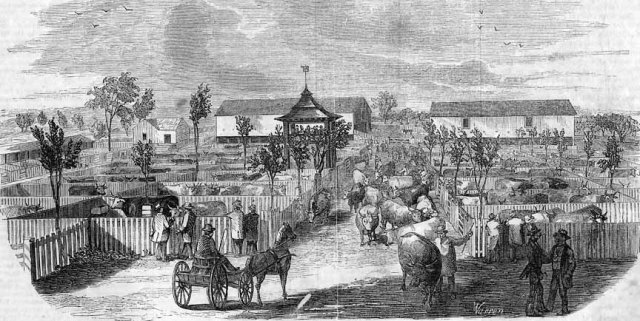 The stockyards behind the Cattle Fair Hotel.
The stockyards behind the Cattle Fair Hotel.
Cattle Drives and Public Safety: The rail head lay at the bottom of the aptly named Market Street (previously Meetinghouse Lane) on the newly constructed Boston & Worcester Railriad (dating from 1835). The roads leading into Brighton were so congested and dangerous on Mondays (Market Day) that Brighton’s public schools operated on a unique Tuesday through Saturday schedule.
 The 1852 Enlargement of the Cattle Fair: The Cattle Fair Hotel was enlarged and remodeled in 1852 by the leading Boston architect William Washburn in the Italianate architectural style. It was the largest hotel in the Boston suburbs, containing some 100 Rooms, a dining room that could seat 500 at a single sitting, and was said to contain the largest saloon in America. It also included a dance hall with a floor built on springs that gently undulated as couples danced.
The 1852 Enlargement of the Cattle Fair: The Cattle Fair Hotel was enlarged and remodeled in 1852 by the leading Boston architect William Washburn in the Italianate architectural style. It was the largest hotel in the Boston suburbs, containing some 100 Rooms, a dining room that could seat 500 at a single sitting, and was said to contain the largest saloon in America. It also included a dance hall with a floor built on springs that gently undulated as couples danced.
 The Cattle Fair Hotel was a popular destination for Bostonians who came here via the Mill Dam (now Beacon Street) and Brighton Roads (built in the 1821-22 period). Newly married coupled often honeymooned at the Cattle Fair, which was the largest, but by no means the only hotel in Brighton. There were six hotels in Brighton Center area alone. Three of these buildings are still standing. Altogether there were nearly 20 hotels in Brighton to accommodate thee thousands who visited the Brighton market annually. A visit to the Brighton Cattle Market was also a popular destination for prominent Americans and even foreign visitors. Nationally prominent figures like Henry Clay, Daniel Webster, and Thomas Hart Benton visited Brighton. Clay claimed to have recognize cattle he saw there as coming from his estate, Ashland, in Lexington, Kentucky.
The Cattle Fair Hotel was a popular destination for Bostonians who came here via the Mill Dam (now Beacon Street) and Brighton Roads (built in the 1821-22 period). Newly married coupled often honeymooned at the Cattle Fair, which was the largest, but by no means the only hotel in Brighton. There were six hotels in Brighton Center area alone. Three of these buildings are still standing. Altogether there were nearly 20 hotels in Brighton to accommodate thee thousands who visited the Brighton market annually. A visit to the Brighton Cattle Market was also a popular destination for prominent Americans and even foreign visitors. Nationally prominent figures like Henry Clay, Daniel Webster, and Thomas Hart Benton visited Brighton. Clay claimed to have recognize cattle he saw there as coming from his estate, Ashland, in Lexington, Kentucky.
A Wild West Town in Staid New England: Brighton Center was a place of startling contrasts. The first Massachusetts State Fairs were likewise held in and around Agricultural Hill on the south side of Washington Street, a stone’s throw from the stockyards. Brighton Center in the 1830 to 1884 period combined elegance with a wild west flavor, with hundreds of transients pouring into the village on a weekly basis, with rowdiness, drinking, gambling, prostitution, and reckless driving as its hallmarks, especially on Mondays, when the Cattle Market was most active.
 An early 20th century view of the building that housed another of the downtown hostelries, the Eastern Market Hotel, situated at the southeast corner of Washington Street and Chestnut Hill Avenue. This structure had formerly stood on the crest of Agricultural Hill where it served as the Exhibition Hall of the Massachusetts Society for Promoting Agriculture. It was moved off the hill to this location about 1840, and still stands.
An early 20th century view of the building that housed another of the downtown hostelries, the Eastern Market Hotel, situated at the southeast corner of Washington Street and Chestnut Hill Avenue. This structure had formerly stood on the crest of Agricultural Hill where it served as the Exhibition Hall of the Massachusetts Society for Promoting Agriculture. It was moved off the hill to this location about 1840, and still stands.
The Eastern Market Hotel: One of these surviving hotel buildings stands at the southeast corner of Washington Street and Chestnut Hill Avenue. Originally called Agricultural Hall, this structure once occupied the site at the head of Dighton Street where the Winship School now stands. It was moved into Brighton Center in the early 1840s and was converted into a hotel owned and operated by hotelkeeper Dodenah Scates.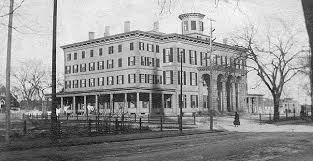 The Faneuil House, as the Cattle Fair Hotel was known in its final years, following the removal of the Brighton Stockyards to North Brighton in 1884.
The Faneuil House, as the Cattle Fair Hotel was known in its final years, following the removal of the Brighton Stockyards to North Brighton in 1884.
The Brighton Center Stockyard Moves. The Cattle Market was relocated from Brighton Center in 1884 to a 30-acre parcel at the northeast corner of North Beacon and Market Streets in North Brighton, conveniently near the Brighton Abattoir, the largest slaughtering facility in the state, which was established in North Brighton in the early 1870s. This had the effect of freeing up acreage in Brighton Center for residential development. An electric streetcar line had been installed along Washington Street in the late 1880s (horsecars had earlier operated on this line). Thus the land on which the Stockyards had stood could now be more profitably utilized for high-style residential development. Known in last years as the Faneuil House, the Cattle Fair Hotel fell into disuse after 1884, but was not finally demolished until the late 1890s.
The North Brighton Cattle Yards: The North Brighton Stockyards, seen above, survived for an additional 70 years following their removal from Brighton Center. Not until the late 1950s and early 1960s did the last vestiges of Brighton’s famous cattle and slaughtering industries disappear from Brighton.
Stop# 3 – Vantage Point: Washington Street opposite the present Brighton & Allston Congregational Church.
 The Brighton Evangelical Congregational Church (1827 building)
The Brighton Evangelical Congregational Church (1827 building)
The Brighton Evangelical Congregational Church: The First Church congregation splintered in 1827. The more conservative members of Reverend John Foster’s church were growing increasingly impatient with his, in their view, too liberal theological views, but they constituted only a minority of his congregation. Under Massachusetts state law, the majority element was entitled to ownership of the church building and its contents. In 1827, the minority broke away and founded a separate church, Brighton’s second religious society, and built a small church on this site, the Brighton Evangelical Congregational Church.
Two aspects of the early history of this church are particularly interesting. The great evangelical preacher, Lyman Beecher, father of Harriet Beecher Stowe, fostered the break away and preached the inaugural sermon at the new church; also the choice of location is of some interest. The evangelicals chose this location because it stood opposite Hastings Tavern, where much heavy drinking occurred. As total abstinence advocates, this placed them in a better position to police the behavior of their fellow citizens.

The Brighton Evangelical Congregational Church (1866 edifice), designed by prominent Brighton-born architect and church member George Fuller. This church burned in a devastating fire in 1921.
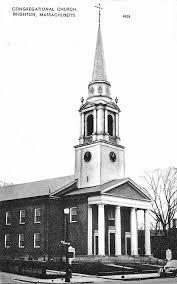
The existing Brighton Congregational Church was built following a disastrous fire that gutted the 1866 edifice. This building was designed by another noted architect, Clarence Blackall, who was primarily a designer of theaters. In all Blackall designed 13 Boston theaters, many of them in collaboration with the great acoustical engineer Wallace Sabine. Blackall-designed theaters included Boston’s Metropolitan Theater (now the Wang Center), and the Colonial and Wilbur Theaters. The excellent acoustics in the sanctuary of the Brighton Congregational Church reflect the influence of Wallace Sabine had on Blackall’s designs.
 The Baldwin-Braman House stood immediately west of the Brighton Evangelical Congregational Church. This house was built by Thaddeus Baldwin, an elder and the most influential lay member of the Brighton Evangelical Congregational Church of his day. The Baldwin family occupied this house until 1842, when it was purchased by Dr. Isaac Braman, who practiced medicine in Brighton for the next 30 years, while also serving as head surgeon at the Watertown Arsenal.
The Baldwin-Braman House stood immediately west of the Brighton Evangelical Congregational Church. This house was built by Thaddeus Baldwin, an elder and the most influential lay member of the Brighton Evangelical Congregational Church of his day. The Baldwin family occupied this house until 1842, when it was purchased by Dr. Isaac Braman, who practiced medicine in Brighton for the next 30 years, while also serving as head surgeon at the Watertown Arsenal.
Stop #4 – Vantage point: intersection of Foster and Washington Streets, looking south.

The residence of Dr. James Whittemore Mansion, a prominent physician, who practiced in Boston as well as in Brighton and other nearby towns. By all accounts he and his near neighbor, Dr. Isaac Braman, were somewhat contentious competitors. Dr. Whittemore was also a noted amateur astronomer. This house stood at the southeast corner of Washington and Foster Streets, on the site now occupied by the building that in past years accommodated Horrigans and Flanagans Markets, and that now serves as a CVS pharmacy. The Whittemore Mansion was taken down about 1940.
 The Noah Worcester House, built circa 1680, the residence of the founder of the America peace movement, a building that also served as Brighton’s first post office.
The Noah Worcester House, built circa 1680, the residence of the founder of the America peace movement, a building that also served as Brighton’s first post office.
Brighton’s First Post Office, 1817: Here stood Brighton’s first post office, established in 1817, in a private residence, the home of the Reverend Dr. Noah Worcester.
 The Reverend Dr. Noah Worcester, “The Apostle of Peace”
The Reverend Dr. Noah Worcester, “The Apostle of Peace”
The Apostle of Peace: Brighton’s first postmaster, Dr. Noah Webster, was a figure of considerable importance in the intellectual and reform history of the United States. He is generally credited with having been the principal founder of the American peace movement. In 1813, while living in this house, Dr. Worcester wrote the first significant work of American Pacifism, “A Solemn Review of the Custom of War” as a protest against the War of 1812. Dr. Worcester was only technically the postmaster of Brighton. The duties of the office (1817-37) were actually performed by his daughter, Sally Worcester. Thus the town’s first postmaster was actually a postmistress. Sally Worcester did an outstanding job of managing the town’s mail for over 20 years and is one of the women featured in the Brighton-Allston Historical Society’s Brighton-Allston’s Women’s Heritage Trail.
The Sad Loss of the Worcester House in 1919: A 1919 effort to save the circa 1680 Worcester House failed when the SPNEA (now Historic New England) refused to purchase the property on the grounds that the interior had been been too extensively altered over the years.
Stop #5 – Brighton’s Cattle Dealers’ District: The Washington Street, Oakland Street, and Malbert Road area.

The most famous of the various cattle dealers and slaughterhouse proprietors who resided in this neighborhood in the heyday of the Brighton cattle and slaughtering trades was Gustavus Franklin Swift, who came originally from Sandwich on Cape Cod. Swift and his family resided at the upper end of Brighton’s Oakland Street in the 1869-70 period, though we are uncertain as to the house he occupied. He also formed a partnership with another Brighton Cattle Dealer, James Ambrose Hathaway. Swift owned and operated a slaughterhouse in Brighton, but again we’re uncertain as to the location. Later he relocated to Chicago where he founded the multi-million dollar Swift Meatpacking Company.
The Cattle Dealer’s District: The area around Oakland Street and Malbert Road, as well as the opposite side of Washington Street, contained the residences of several well-to-do cattle dealers and slaughterhouse proprietors. Survivals include the Stetson residence (later the McNamara Funeral Home) and the Ricker and Munroe residences on Malbert Road. The area is accordingly referred to as Brighton’s Cattle Dealers District. This neighborhood was situated far enough away from the cattle yards so as not to be disturbed by its noises and smells, yet close enough to be convenient for conducting daily business at the yards. In addition the neighborhood stood on high ground that commanded an excellent view of the picturesque hills of Brighton to the southwest.

James Lloyd Lafayette Warren, Master Horticuturalist
James Lloyd LaFayette Warren: The Father of California Agriculture: The area to the southwest, in and around Nonantum Hill, was the principal locus of Brighton’s great nurseries, horticulture being the town’s other great industry in the 19th century. The nearest of these nurseries (the Nonantum Vale Nursery) hugged the western edge of Lake Street, opposite present day Roger’s Park. It was established by James Lloyd Lafayette Warren about 1825. Warren raised the first commercially grown tomatoes in Massachusetts and imported the first tulips into Boston. In 1849, at the time of the California Gold Rush, he sold his Brighton property and migrated (via Cape Horn) to California, where he established that state’s first agricultural supply store, organized that state’s first agricultural society and its state fairs, and launched the state’s first agricultural journal. Thus this Brighton horticulturalist came to be known as the “Father of California Agriculture.” For additional details on the life of this interesting individual, I refer readers to the article tI recently posted on this blog on the life and career of James L.L.F. Warren.
Warren was just one of Brighton’s great nurserymen—the other leading Brighton figures in that industry included Jonathan and Francis Winship, who pioneered the industry here, Joseph Breck (founder of the Breck Seed Company) and his son-in-law William C. Strong. Breck and Strong both served as Presidents of the Massachusetts Horticultural Society in the 1860s and 1870s.
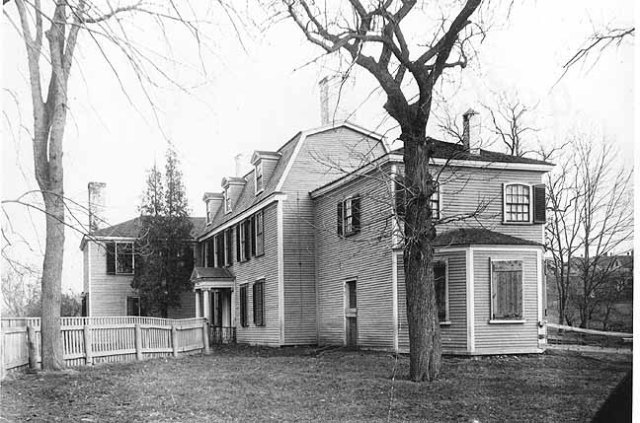
The Parsons Mansion, the residence of gentleman farmer Gorham Parsons. The mansion the the core of which dated from the the late 1600s, stood at the southern end of the 70-acre Parsons property, known as Oakland Farms, facing Faneuil Street. Parsons Street runs running along the eastern edge of the estate, commemorates this prominent local resident.
Oakland Street runs through the center of what was once the estate of Gorham Parsons, known as Oakland Farms. Parsons, a prominent “gentleman farmer,” nephew of the famous Judge Theophilus Parsons, was active in local government, serving for a time as a State Senator. Parsons sold off his Brighton estate in smaller parcels in 1837 and returned to his native town of Byfield, Massachusetts.
Stop #6 – Eastburn Street Area:
 St. Margaret’s Episcopal Church
St. Margaret’s Episcopal Church
St. Margaret’s Episcopal Church, 1864: At the southwest corner of Washington and Eastburn Streets once stood St. Margaret’s Episcopal Church, built in 1864. The Eastburn Street area was strongly identified with Episcopalianism owing to two other circumstances: St. Margaret’s stood next to the childhood home of Cyrus T. Knight, who in 1889 would become an Episcopal bishop. In addition the name Eastburn, which was applied to the street in 1886, memorializes Manton Eastburn, the Episcopal bishop of Massachusetts. Prior to 1886, the street had been called Worcester Street, after Dr. Noah Worcester, and then, after the building of St. Margaret’s Church in 1864, it was briefly called Church Street. St. Margaret’s Church, which was partially damaged by fire, was demolished in the 1970s. The first building on the right hand side of Eastburn Street, just beyond the site of the church, was originally a parish hall, but is now a private residence.
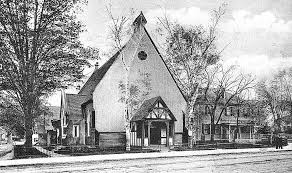 An earlier view of St. Margaret’s Episcopal Church, circa 1900. The house to the right, at the corner of Washington and Foster Streets, which still stands, belonged in 1900 to Thomas P. Bray.
An earlier view of St. Margaret’s Episcopal Church, circa 1900. The house to the right, at the corner of Washington and Foster Streets, which still stands, belonged in 1900 to Thomas P. Bray.
An Early Immigrant Neighborhood: The buildings along the southern side of Brighton Center are generally older than those along the northern side. Eastburn Street accommodated one of Brighton’s earliest largely immigrant Irish/ working class districts, going back to the 1840s. The Corcoran House, which still stands just beyond the parish hall building, was the site of the first Catholic services held in Brighton, in the 1840s. Brighton first Catholic church, St. Columba’s, established in 1855, stood on Bennett Street near the Market Street intersection. Unfortunately, we have no picture of this building is known to exist.
We will now climb a set of stairs leading from the east side of Eastburn Street to the top of Brighton’s historic “Agricultural Hill.”
Stop#7 – Vantage Point: The Top of Agricultural Hill (Dighton Street) facing the Winship School.

The Winship School, dating from 1899, was built on the site of Agricultural Hall and the Massachusetts Society for Promoting Agriculture Fair Grounds,where the first State Fairs in Massachusetts were held in the 1816-35 period. We see the Winship School as appeared before the addition of a third story in the late 1920s.
The MSPA Fair Grounds and Agricultural Hall, 1816-1835: Here we see the original site of Agricultural Hall & the MSPA Fair Grounds. The parcel of land on which the Winship School now stands was donated to the Massachusetts Society for Promoting Agriculture in 1816 by wealthy Boston merchant Abiel Winship, the eldest son of Jonathan Winship II children, co-founder with his father Jonathan Winship I of the Brighton cattle and slaughtering industries back in 1776. Unfortunately we have no image showing Agricultural Hall at its original location. This is the building that was moved to the corner of Washington Street and Chestnut Hill Avenue in 1840 and converted into a hotel. (as noted above) The Winship brothers made the first attempt to establish a trading post on the Columbia River some months ahead of John Jacob Astor. This illustration shows their ship “The Albatross” at Oak Point on the north shore of the Columbia River in the present state of Washington in 1810. Flooding and the hostility of the local natives doomed this commercial venture, which was abandoned in a matter of months.
The Winship brothers made the first attempt to establish a trading post on the Columbia River some months ahead of John Jacob Astor. This illustration shows their ship “The Albatross” at Oak Point on the north shore of the Columbia River in the present state of Washington in 1810. Flooding and the hostility of the local natives doomed this commercial venture, which was abandoned in a matter of months.
Homer & Winship and the Pacific Trade: Abiel Winship accumulated a sizable fortune in trade along the Pacific coastline, in Alaska, Hawaii, and China. Although he never personally visited the Pacific, he sent his younger brothers, Charles, Jonathan III, and Nathan Winship on a variety of expeditions, sponsored by his trading company, Homer & Winship. Abiel’s partner in this enterprise, incidentally, was the grandfather of the painter Winslow Homer. Brighton’s Winship brothers made singular contributions to the development of trade between the United States and Pacific region. These included the first commercial contacts between the U. S. and Russian America (Alaska), large-scale sea otter hunting along the California coast, assistance extended to King Kamehameha in unifying the Hawaaian Islands, and the first (albeit unsuccessful) attempt to establish a permanent American presence on the Columbia River at Oak Point in the present state of Washington, pictured above.
Winship Family Contributions: The great historian of seafare Samuel Eliot Morison referred to these Brighton men as “The Remarkable Winship brothers.” Note should also be taken here of the scope of this family’s contributions to the history of Brighton, of Massachusetts, and the nation, services that included, in addition to their Pacific ventures, the founding of the local cattle and slaughtering trades, so important to the Revolutionary cause ands the New England economy, Abiel Winship’s contribution to the prosperity of Brighton in bringing the MSPA annual fairs to the town, the establishment by two Winship brothers, Jonathan Winship III and Francis Winship of Brighton’s very first horticultural enterprise, the 40 acre Winship’s Gardens in North Brighton in 1820, the services of the next generation of Winships, the brothers F. Lyman and J.P.C. Winship on both the Brighton and Boston School Committees, and J.P.C. Winship’s authorship of the first history of Brighton, the two-volume Historical Brighton, published in 1899 and 1901.
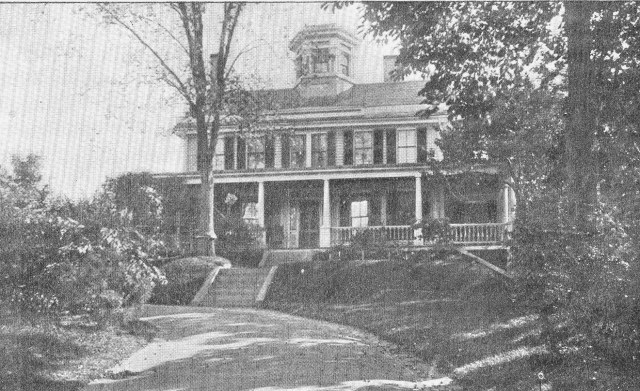 The Hale-Eldredge-Collins House
The Hale-Eldredge-Collins House
The Hale-Eldredge-Collins House, which stands directly behind the Brighton-Allston Congregational Church, accommodated a number of prominent residents over the years.

Nathan Hale II, the first President of the Boston & Worcester Railroad, and his son, the future author, Edward Everett Hale, both briefly occupied this house while the B&A Railroad was under construction.

Edward Everett Hale, the author of “The Man Without a Country,” a prominent Boston minister lived in Brighton briefly as a young man while attending Harvard College.
Diagonally across the street on land adjoining the Congregational Church stands a house of considerable historic importance, which has, unfortunately, seen much modification over the years.
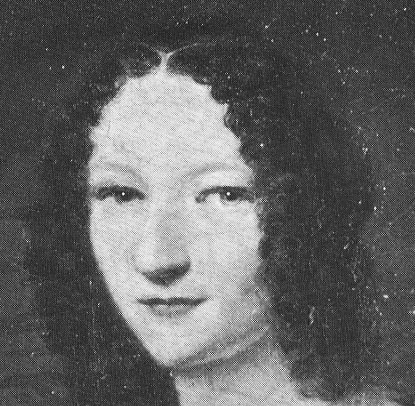 Sarah Payson Willis Eldredge (aka “Fanny Fern”), noted feminist, columnist, and author of the novel “Ruth Hall,” the plot of which was based on her period of residence in Brighton.
Sarah Payson Willis Eldredge (aka “Fanny Fern”), noted feminist, columnist, and author of the novel “Ruth Hall,” the plot of which was based on her period of residence in Brighton.
In the mid 1840s this house was the residence of the Eldredge family, the in-laws of the author Sarah Payson Willis (pen name “Fanny Fern”–an early women’s rights advocate, novelist and popular columnist). Sarah and her husband Charles Eldredge lived here briefly following their marriage before purchasing a 15 acre estate on Brighton’s Foster Street, a property that is thought to have included some of the land now comprising Roger’s Park, an estate to which the Eldredges gave the name “Swissdale.”
This house behind the Congregational Church was later acquired by David Collins, another prominent Brighton cattle dealer.
The Cook House: A sense of the openness of Brighton in the mid-19th century is gained from the following details. The Cook House, the back of which we see across Dighton Street from the Hale-Eldredge-Collins House, and which is now hemmed in all around by neighboring structures, originally had a front yard (an orchard) that extended all the way to academy Hill Road, evidencing that Brighton’s was open and verdant in the early 19th century. In 1860 the town, comprised of only 4 1/4 acres, contained no less than 57 farms comprising fully two-thirds of Brighton’s surface area.
Stop #8: The intersection of Dighton Street and Academy Hill Road:
 The James A. Hathaway Hathaway Mansion
The James A. Hathaway Hathaway Mansion
The James Ambrose Hathaway Mansion, home of the business partner of Gustavus Franklin Swift, stands at the far end of Dighton Street, at its intersection with Academy Hill Road and Chestnut Hill Avenue. One of the most elaborate private residences in Brighton, this Colonial Revival style house, the work of prominent Boston architect Julius Schweinfurth, dates from 1899. While Swift moved to Chicago where he established one of the nation’s leading meatpacking concerns, Hathaway remained in Brighton and made a fortune in exporting cattle to Great Britain.
See part 2 of this walking tour, posted above, covering the more easterly portion of Brighton Center.

Hi great readiing your blog
LikeLike